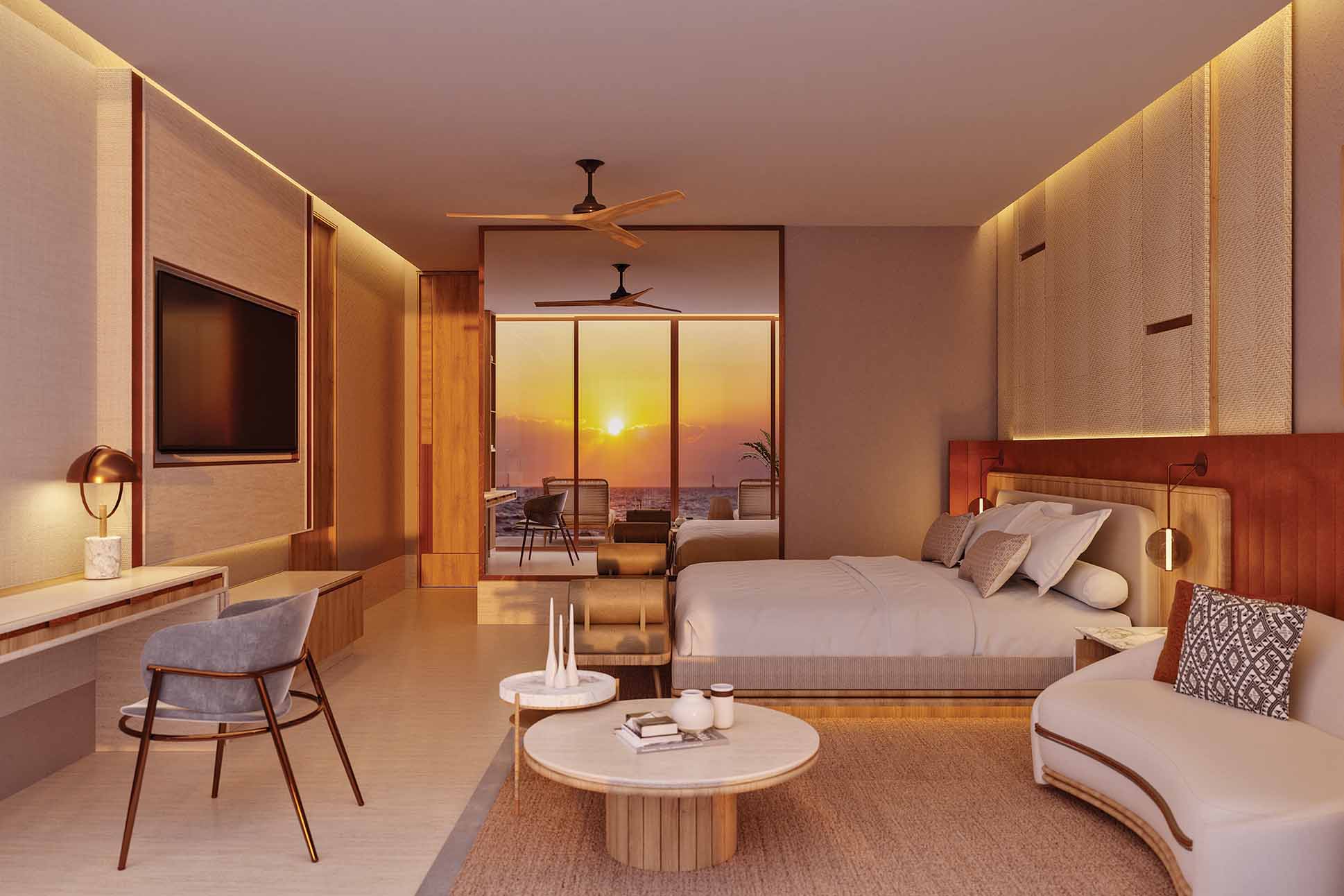Text by David Shortell
Images by Alex Azabache, AB Living, and Joseph Barrientos
Carved from a forest of palm trees, Costa Mujeres is a respite for the overstimulated. It offers generous swaths of the last remaining virgin, white sand beaches in Quintana Roo, the Mexican state long known for its breathtaking seaside beauty. And local development, mostly begun in just the past decade, is now playing out with luxury top of mind.
The dozen-mile stretch sits out past Cancún and the high-rises and rollicking restaurants that have turned that resort town into one of Mexico’s most popular beach destinations, up a thin strip of land extending into the Caribbean Sea that barely registers on the map. This is a good thing.
As the historic hotel zone in Cancún nears building capacity, new construction in the region has shifted to Costa Mujeres, a half-hour away. New resorts are built in a sort of eco-modern style, blending together with the natural environment. There are none of the shopping centers and markets that crowd other Mexican beach towns.

“It will undoubtedly be the new luxury tourism corridor for the Mexican Caribbean,” says Alejandro Bataller, vice president & CMO of AB Living, a developer behind a number of high-end properties set to open in Costa Mujeres in the coming years, including the first St. Regis in the Cancún area.
“It provides an atmosphere of calm and privacy,” he adds.
With its soft-curving pools and superlative vistas, Costa Mujeres is perfect for the vacationer whose ambitions extend no further than a lounge chair. But choose to venture outside, and filling up an itinerary makes for fun work.
Fernando Torres has been crafting private outings in the area through his Playa Mujeres Trips and Tours since the first hotels rose up. In his catalog: the best spots for snorkeling, fishing, zip-lining, and ruin-hopping. But the array of local wildlife might steal the show. “There are iguanas of every size. You’re going to see them everywhere,” Torres said. “You’ll see flamingos, you’ll see many herons. Then we’ll get on the water and out past the hotels, you can see dolphins, and a bit further away, toucans.”

Cancún is, of course, right there—a sober drive to the cantinas and nightclubs slinging cold Corona and tequila being the only ticket needed for revelry.
But think bigger, and at Isla Blanca, the narrowest point of the region, only a few hundred meters of sand separate two staggering coastlines. To the east, the Caribbean; to the west, a vast lagoon that’s dotted with the floating Day-Glo parachutes of a school of kitesurfers.
“It’s the best place to learn,” said Gianpaolo Cangiano, the owner and an instructor at Kitesurf Mexico.
Strong north winds propel the surfer, tethered with a harness to his kite, like a sail. Calm, hip-high waters are generous to wobbly beginners. Cangiano says he’s taught ages seven to 70. “Often, we’ll start teaching a family member, and then the wife and the children will want to join. There are entire families that kitesurf,” he said.
For a more traditional, land-based sport, two marquee names stick out: Greg Norman and Rafael Nadal. Both iconic athletes have exclusive outposts in the area.

Norman, the golf tycoon and former world No. 1, is known for building courses that match their surroundings. In Costa Mujeres, that means 18-holes lined by palm trees and Caribbean views pushing sea breezes that demand precise swinging.
At the Rafa Nadal Tennis Centre, the Spanish king of clay’s only training facility in North America, group and private lessons for all levels are taught by coaches versed in the same method that Nadal has relied on to earn 22 Grand Slams, prioritizing mobility, intensity, and forward-thinking.
Down the beach from the state-of-the-art facilities, which include eight clay courts and a museum housing some of Nadal’s trophies and gear, lives a markedly less modern site: the El Meco ruins, a Mayan trading center dating back to between 300 and 600 A.D.
Archaeologists believe the settlement played an important part in the maritime traffic of the ancient inhabitants in the area, down to the influential city of Coba. At its center, a steeply tiered pyramid looms 12.5 meters high.
The marriage of the ancient and modern is a theme here. And at María Dolores, the Costa Mujeres outpost of celebrity chef Edgar Núñez, elements of Mayan cuisine play a starring role.
Núñez is among the most important purveyors of his country’s cuisine in the world: his Mexico City homebase, Sud 777, is one of just four Mexican restaurants on the list of the World’s Best 100. At María Dolores, dramatic stone pillars and rich leather seating provide a transformative fine-dining experience.

The recados are a favorite. A kind of Mayan mole, the sauces are prepared to dress an octopus and suckling pig dish by a designated member of the kitchen staff. “Before, in the towns, there used to only be one mill,” Núñez says in an interview, “and people would bring what they planted to the recaudería”—a collecting site or store—“and the miller would grind them to a paste. That’s where the name recado comes from: from collecting things.”
“I try to get a little inspiration from all the cultures of my country,” Núñez says.
Perhaps that’s the majesty of Costa Mujeres, a seamless combination of all that this country has to offer: inspiring history, unparalleled nature, and some of the best food you’ll ever eat. And it’s all just beginning here in Mexico’s newest paradise.




